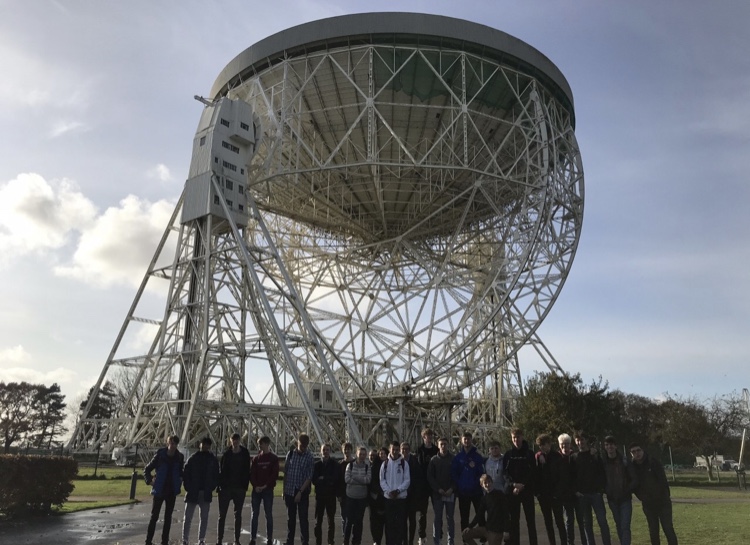PHYSICS: Students enjoy a stellar day out

GCSE astronomy and A-level physics students enjoyed a fascinating visit to the Jodrell Bank Observatory, which is at the forefront of the most exciting international astronomical research. ELLEN McKEAG, LAYLA OSMAN and CAMERON KNOX report
AT the Jodrell Bank Discovery Centre, our GCSE astronomy group enjoyed two workshops, one on exoplanets and the other on stellar evolution.
We discussed our own solar system before moving onto what exoplanets actually are and how we observe them. To demonstrate how we observe these planets outside our solar system we did a simple experiment with a lightbulb, a small ball of Blue Tac on a string and a light meter, with the bulb representing a star and the Blue Tac representing an exoplanet in orbit around the star.
We moved the ‘planet’ around the ‘star’ in an orbit and used the light meter to measure the intensity of the light from the bulb. By doing this we produced a graph which showed small dips in our ‘star’s’ light, the reduced light level caused by the Blue Tac moving in front of the bulb.
With this information we calculated the percentage of light blocked by the ‘planet’ and then, to make our results more realistic, we multiplied the time for one ‘orbit’ by 100 days and then converted to earth years. Using this we calculated the distance of our planet from its star using Orbit time2=Distance3 and then the radius of our planet in km, assuming our star is identical to the sun, using the equation Area=B (percentage of light blocked) x Area of star.
At the end of the workshop we worked out that our planet had an orbit of 0.27 earth years, blocked 2.21% of the star’s light when transiting, was 0.42 AU from its star and had a (doubtful) 1040624 km radius. We had a planet bigger than Jupiter orbiting the star at the same distance as Mercury orbits the Sun. However, although our results seemed unlikely, we all came away with a deeper understanding of how we find exoplanets in deep space.
In our stellar evolution workshop, we considered the life of stars, starting with a true or false exercise about our Sun and other stars. Afterwards we talked about what makes stars shine: fusion. We played bingo with a twist, each square representing a different element up to iron (as that is what stars can fuse up to) whose nuclei we had to make with Lego pieces that represented protons and neutrons.
To finish off this fascinating topic we went through the different stages of stellar evolution for small and massive stars, from main sequence to super nova to black hole. To help with understanding we were also shown demonstrations of how black holes and supernovas work, although massively scaled down.
Overall it was an interesting trip and we learned lots of fascinating facts about some of the most interesting phenomena in space and it was amazing to see the huge Lovell telescope, one of the largest in the world, with our own eyes.
Ellen McKeag
OUR visit to the Jodrell Bank Discovery Centre involved seeing interesting exhibitions as well as workshops about pulsars and radio telescopes. Whilst on site we were told to keep our phones on aeroplane mode or turn them off. This was to prevent our phone signals being detected by the telescope and therefore interfering with their research and observations. Along with no phones on the site there are also no microwaves or Wi-Fi for the same reason.
The first exhibition was the Planet Pavilion. Here, we learnt more about our solar system and how it developed from the explosion of massive stars causing the creation of black holes to the formation of planetary nebulas (when less massive stars run out of fuel and lose their outer layer). On the ceiling was a moving model of our solar system where the time taken for the planets to orbit the sun is to scale and one minute is equal to one Earth year.
Next was the Space Pavilion, this included many more exhibits about the stars and the universe in general. It was intriguing to learn that the first star wasn’t formed until about 400 million years after the Big Bang and you can work out the mass of a star and how far away it is from just how much it ‘wobbles’ compared to other stars.
This was followed by a radio telescope workshop in which we learnt more about the Lovell Telescope itself. The telescope cannot work properly unless the shape is exactly what was designed and the temperature is -260˚C. If these are not exact the signal received could be unreliable.
Next we learnt about what the signals received can actually tell us about stars. From using the speed at which a galaxy is moving away from us, how fast it is spinning and its radius we can work out the whole mass of the galaxy. Another way to work out the mass is by estimating the visible mass of a galaxy. However, this is a lot lower than the other method, thus supporting the theory of dark matter (matter of which we don’t know what it is e.g. black holes).
We ended the day with a second workshop on pulsars (small spinning stars that shoot out radiation at their poles). I was amazed to learn that they spin at 714Hz, which is a faster than a food processor at 380Hz but slower than a Dyson vacuum at 2000Hz. It was also fascinating to learn that in 1967, Jocelyn Bell Burnell first detected bursts of radio waves - pulsing signals – leading to the discovery of pulsars.
Overall it was a very enjoyable and educational day.
Layla Osman and Cameron Knox







